This is the third installment in a multi-part series on the tourism sector in Nunavut post-pandemic.
The expansion of the Nattilik Heritage Centre in Gjoa Haven could be a boon for the community’s struggling tourism industry.
Construction of the expanded heritage centre, which is being led by Yellowknife-based Northern Industrial Construction and Taylor Architecture Group, is expected to begin later this summer, and conclude in March 2025.
The grand opening will most likely occur soon after that, when the weather warms up, according to project manager Campbell Cameron of Four Peaks Consulting Group.
“Design of the building is effectively complete,” he said in early August. “Northern Industrial Construction are arriving in a little over a week, at which point they will start the civil construction.”
The heritage centre expansion was initially expected to cost $6 million, but the price tag increased to $9 million after the pandemic. Funding has been provided by numerous sources, including the Kitikmeot Inuit Association, the Canada Cultural Spaces Fund, and the Government of Nunavut.
The opening of the facility will loosely coincide with the opening of the Wrecks of HMS Erebus and HMS Terror National Historic Site, which is the responsibility of Parks Canada and local Inuit.
Erebus and Terror, the three-masted wooden vessels used on Sir John Franklin’s ill-fated Arctic voyage, sank near Gjoa Haven after getting stuck in the sea ice and abandoned sometime around 1846. The ships were discovered underwater, in relatively good condition, in 2014 and 2016, respectively.
A team of Parks Canada archeologists, Inuit knowledge-holders and other experts are in the process of researching, documenting and preserving the wrecks in hopes of eventually opening them to tourism.
Parks Canada could not provide a time frame for the opening of the sites, nor any information on the kind of activities tourists will be able to partake in, noting that “it would be premature to confirm what activities will be permissible before this process is completed and proper community and stakeholder consultation has been completed.”
However, more than 100 of the artifacts discovered on the ships will end up in the expanded heritage centre in Gjoa Haven which, at roughly 125 km away, is the closest community to the wrecks.
Despite being underwater for well over 150 years, many of those artifacts are in remarkably good condition. It is not yet clear which items will end up in the centre’s collection, but discoveries so far include clothing garments, such as boots and mittens, paintbrushes, dishware and even some coffee beans.
The centre will also feature an impressive collection of Inuit artifacts, many of which were used around the time of Franklin’s last expedition, as well as artifacts on loan from other museums and the Government of Nunavut.
“The idea behind the exhibit has kind of expanded from just being about the Franklin expedition,” Cameron said. “It’ll be more of a braided storyline connecting the Franklin expedition and life in the Arctic during that time and from earlier times as well.
“The idea is to showcase some of the tools and equipment that the Franklin explorers would have been using and comparing that to what the Inuit would have been using.”
Beacon for tourists
The expansion will add 4,800 square feet to the centre’s existing 3,300-square-foot footprint, and will also feature space for a range of community programming.
The expectation is that it will bring tourists to Gjoa Haven, particularly those who visit the area to explore the shipwrecks when they eventually open.
“That’s definitely the hope,” Cameron said. “It’s going to attract a lot of people, just to be able to lay their eyes on some of these artifacts that have been so well preserved at the bottom of the Arctic Ocean for so long. They’ll be able to see these right in the centre and get a really close look at them.”
Tourism in Gjoa Haven has seen better days, with the Covid-19 pandemic proving particularly damaging to the industry.
Charlie Cahill, a former tour operator who was forced to close his business during the pandemic, painted a grim picture of the state of the local industry, calling the the crisis “the death knell of tourism” in the area.
However, he believes the expansion of the heritage centre and opening of the wreck sites could be a saving grace.
“That could be a big tourism draw,” he acknowledged. “Once that’s up and running you might see an improvement or increase.
“You need something to bring people in.”
Cameron could not provide any figures on the projected financial benefits of the expanded Nattilik Heritage Centre, but he shares Cahill’s belief that it could help revive the local tourism industry.
“So many people around the world are so interested in this Franklin expedition and the mystery that revolves around it,” he said. “It’s going to be a good opportunity for the community to optimize tourism.”
Ottawa-based firm Origin Studios will lead the creation of the exhibition itself.
Franklin’s expedition with the Erebus and Terror was intended to navigate the last unexplored segments of the Northwest Passage. All 129 crew members died, either on the ships, or on the land after they disembarked.
